The prevalence of cellphones and mobile coverage nationwide has caused most payphones to disappear from public places.
In 1999, payphones were at their peak in Taiwan, with 150,000 of them nationwide contributing a record NT$8.6 billion (US$300.56 million at the current exchange rate) from prepaid and stored-value phone cards, the National Communications Commission (NCC) said.
Last year, the nation had 36,000 payphones, the commission said.
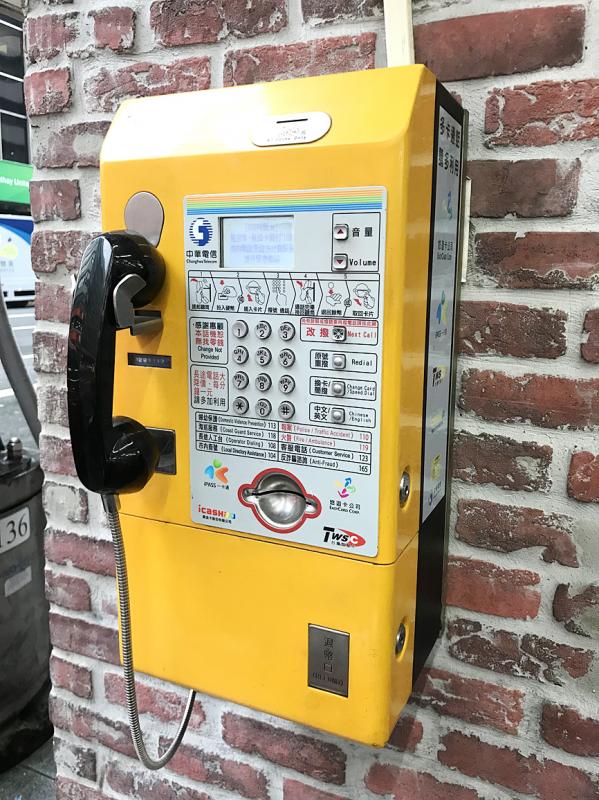
Photo: Yang Mien-chieh, Taipei Times
An NCC report shows that Taiwan’s first public payphone was installed in 1947, while the biggest wave of installations happened in 1981, when the government ran a nationwide campaign with the slogan: “A telephone in every village.”
As mobile coverage has spread and more people have switched to cellphones, telecoms have cut operating costs by gradually removing payphones, an 80 percent decline from 1999 to last year, NCC data showed.
From 1999 to last year, payphone revenue fell 98 percent to NT$110 million, the data showed.
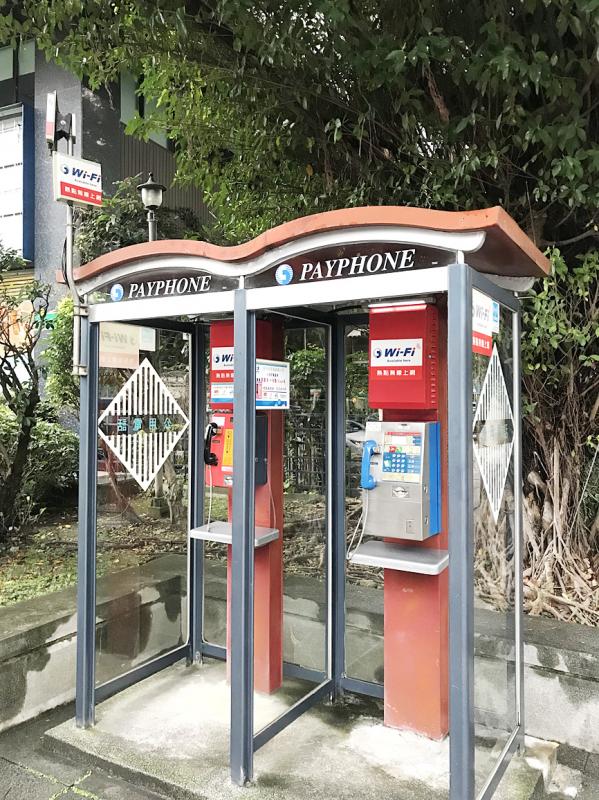
Photo: Yang Mien-chieh, Taipei Times
For example, payphones in Taichung have declined from a high of more than 10,000 phones to fewer than 1,000. The city’s densest concentration of payphones, at more than 400, is at the Chenggong Ling (成功嶺) military training base.
Before a local COVID-19 outbreak in May last year, each payphone at Chenggong Ling took in about NT$300 to NT$400 per month, with some taking in more than NT$1,000, NCC Vice Chairman Wong Po-tsung (翁柏宗) said.
“Although public payphone use is declining, we must still make them available to the public, because government policy is to serve rural regions and villages, and to uphold the rights of those who cannot afford a cellphone,” he said.
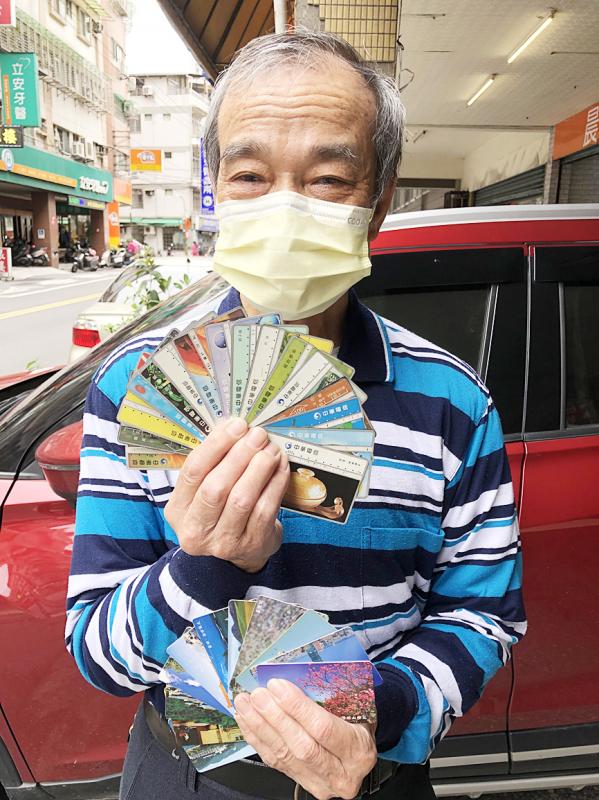
Photo: Yang Mien-chieh, Taipei Times
“To provide all of society with telephone access, we provide subsidies to telecoms so that rural regions have two payphones within a 200m radius and other areas have one payphone per 2km2,” he added.
The commission said that it subsidizes payphones that do not generate revenue at each primary and secondary school, hospital, railway and bus station, and mountainous area, as the public must be provided access to phone service.
In 2020, the subsidies totaled NT$87 million, it added.
Wong said that 4G coverage nationwide is 99 percent, including in rural regions.
“For example, Chunghwa Telecom offers 98.54 percent 4G coverage in rural regions and 91.24 percent 5G coverage,” Wong said.
“We will require all telecoms to expand 5G coverage and quality nationwide. Right now, we are pushing for online connection via satellite systems to resolve signal reception issues in rural regions and outlying islands,” Wong added.
Prepaid phone card sales have declined from 11.67 million cards sold for NT$2.34 billion in 2000 to 48,0000 cards sold for NT$68 million last year, a decline of more than 80 percent, NCC data showed.
Prepaid phone card collector Yang Tzu-tsai (楊子才) said he began collecting when he was young.
Yang said he would scavenge the greater Taipei area for cards that people had not bothered to retrieve from the payphone after making their call.
“My collection is of cards that Chunghwa Telecom produced for its payphones,” Yang said.
“Most of the cards have prints of unique Taiwanese architecture, like Taipei 101 and the Presidential Office Building,” he said.
Some people would collect cards with prints of natural attractions or festivals, such as the Orange Daylily Festival at Hualien County’s Lioushihdanshan (六 十石山) or the Alishan Cherry Blossom Festival, while others collected those with famous museum exhibit pieces or cultural events, such as the Donggang Boat-Burning Ceremony in Pingtung County.
Telephone booths were popular spots at most barracks, Yang said, adding that in the 1950s and 1960s, men had to do two or three years of mandatory military service, depending on their unit.
“A prepaid phone card was a must for young men in the military. Families would send cards to their sons and some local governments would hand them out as gifts,” he said.
Many stories were told of young men waiting in long payphone line to call their girlfriends, he said.
Additional reporting by Jason Pan
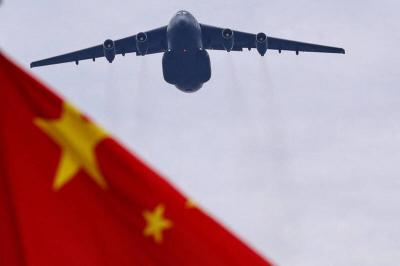
Beijing could eventually see a full amphibious invasion of Taiwan as the only "prudent" way to bring about unification, the US Department of Defense said in a newly released annual report to Congress. The Pentagon's "Annual Report to Congress: Military and Security Developments Involving the People's Republic of China 2025," was in many ways similar to last year’s report but reorganized the analysis of the options China has to take over Taiwan. Generally, according to the report, Chinese leaders view the People's Liberation Army's (PLA) capabilities for a Taiwan campaign as improving, but they remain uncertain about its readiness to successfully seize
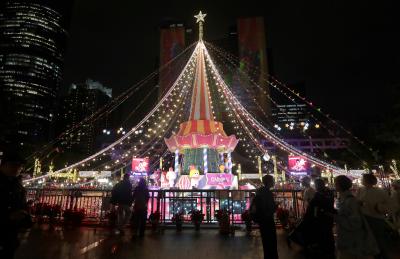
Taiwan is getting a day off on Christmas for the first time in 25 years. The change comes after opposition parties passed a law earlier this year to add or restore five public holidays, including Constitution Day, which falls on today, Dec. 25. The day marks the 1947 adoption of the constitution of the Republic of China, as the government in Taipei is formally known. Back then the Chinese Nationalist Party (KMT) governed China from Nanjing. When the KMT, now an opposition party in Taiwan, passed the legislation on holidays, it said that they would help “commemorate the history of national development.” That

Taiwan has overtaken South Korea this year in per capita income for the first time in 23 years, IMF data showed. Per capita income is a nation’s GDP divided by the total population, used to compare average wealth levels across countries. Taiwan also beat Japan this year on per capita income, after surpassing it for the first time last year, US magazine Newsweek reported yesterday. Across Asia, Taiwan ranked fourth for per capita income at US$37,827 this year due to sustained economic growth, the report said. In the top three spots were Singapore, Macau and Hong Kong, it said. South

Snow fell on Yushan (Jade Mountain, 玉山) yesterday morning as a continental cold air mass sent temperatures below freezing on Taiwan’s tallest peak, the Central Weather Administration (CWA) said. Snowflakes were seen on Yushan’s north peak from 6:28am to 6:38am, but they did not fully cover the ground and no accumulation was recorded, the CWA said. As of 7:42am, the lowest temperature recorded across Taiwan was minus-5.5°C at Yushan’s Fengkou observatory and minus-4.7°C at the Yushan observatory, CWA data showed. On Hehuanshan (合歡山) in Nantou County, a low of 1.3°C was recorded at 6:39pm, when ice pellets fell at Songsyue Lodge (松雪樓), a